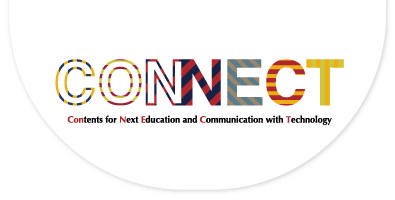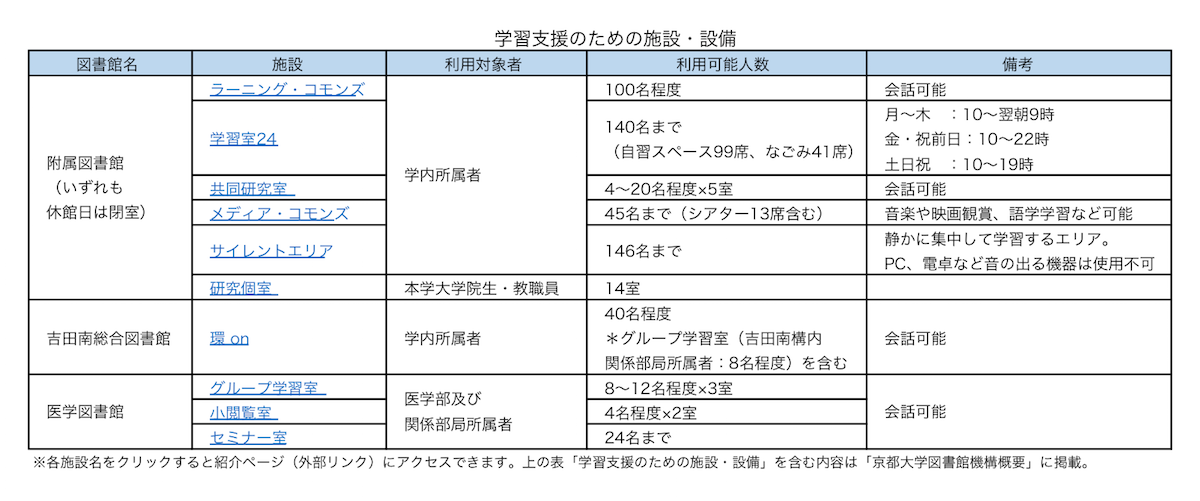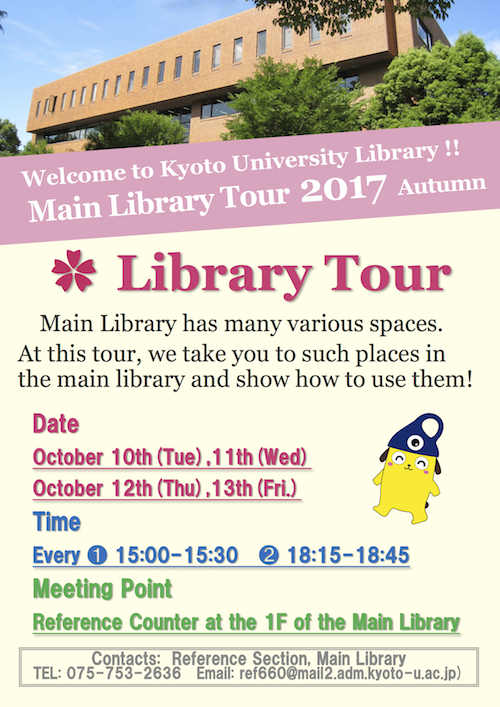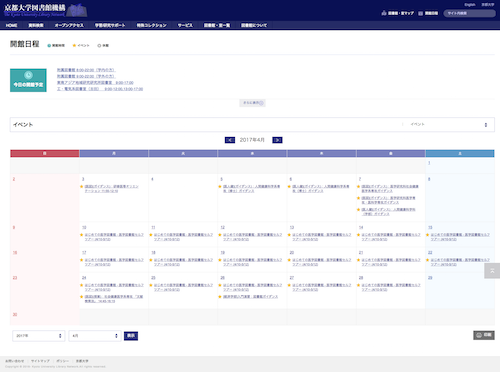TopicsTeacher Interview
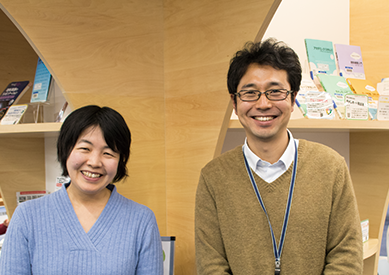
Library Network's Efforts on Supporting Students' Individual Learning Needs
Associate Professor Yumi Kitamura and Mr. Taku Sakamoto (Library Support Section Chief), Kyoto University Library
Kyoto University encompasses libraries in about 50 locations, including Kyoto University Library, libraries of faculties, departments, and research centers located across all campuses. In this interview, we talked with two library staff, Mr. Sakamoto (Library Support Section Chief) of Kyoto University Library, and Dr. Kitamura, with whom we interviewed earlier (see 'Hands-On Practice at the Library That Empowers Students to "Step Forward"'). Out of the many services and resources available at Kyoto University Library Network, the two interviewees picked up a couple of their support services that these library staff think might have a positive impact on Kyoto University's faculty members of different institutes. (Honorific titles are omitted hereafter)
Changes in Students' Library Use and Their Diverse Learning Styles
Mr. Sakamoto, you have been working at Kyoto University Library for 12 years now. Have you seen any changes in students' library use and their learning styles?
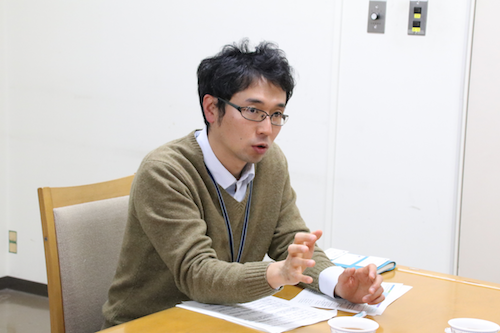
Sakamoto: To my eyes, it seems that the use of the library has become increasingly diverse over the years.
For instance, students nowadays opt for in-house spaces where they can have discussions.
Inside Kyoto University Library, there is a space that boosts students' group communications and co-learning, such as the Learning Commons*1. Meanwhile, the library has designated areas for silent and individual study (Silent Area*2). Surprisingly enough, during the exam periods, the silent study areas always have empty seats available, while other areas are all occupied. This is way beyond what we anticipated.
Another key trend is that a majority of students nowadays study with drinks. Inside the library, only drinks with lids or caps are allowed, but non-spill proof drinks cannot be brought into the library. Lately, an increasing number of students come to the library with a coffee cup purchased at Tully's Coffee located in the underground floor of Clock Tower. It might be an emerging trend that students look for spaces like Starbucks to study casually.
That's an interesting point. Does this imply that more learning options have become available for students?
Kitamura: Absolutely. Currently, the library offers several purpose-specific spaces to its users, including the Learning Commons, Media Commons*3, and Study Room 24*4. Kyoto University Library has been trying to create flexible and multipurpose facilities. Out of the past and ongoing efforts, the Learning Commons has been very impactful to the users since it opened in April 2014.
*1 Learning Commons: Spaces that invite students to participate in group activities, discussion, rehearsal for presentations, etc.
*2 Silent Area: Reserved spaces for silent and individual study. The use of devices that generate noise, eg. PCs, desktop calculators, is prohibited.
*3 Media Commons: Spaces where a variety of audiovisual and multimedia equipment, including CDs, DVDs, videos, etc. is available for listening to music, watching movies, and studying languages.
*4 Study Room 24: Study spaces open for almost 24 hours a day.
Concepts of the Learning Commons: Designing Diversifying Learning Space
Could you give us an outline of what the Learning Commons at Kyoto University Library does?
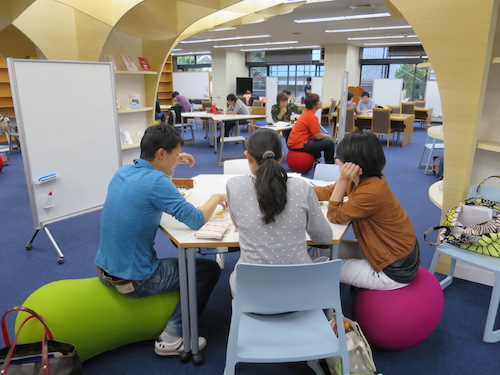
Students having a discussion at the Learning Commons (image provided by Library Network)
Sakamoto: Users have access to movable desks and chairs, whiteboards, three projectors, an electronic blackboard, etc. Users, namely Kyoto University students and faculty members, can take full advantage of the area for collaborating, sharing learning experiences, and rehearsing presentations with the available equipment.
How did you come up with the idea of creating a learning commons in the library?
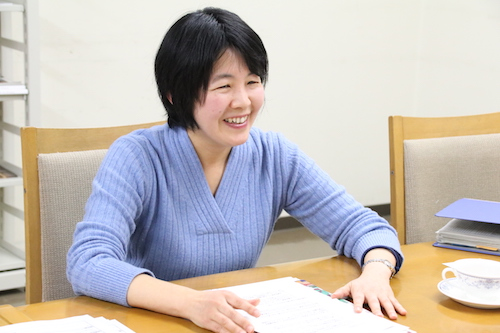
Kitamura: The origin of the learning commons initiatives in Kyoto University Library dates back to 2012 when a working group was formed with an eye to improving library usability. We discussed extensively the pros and cons of setting up a learning commons and how to incorporate it to transform our library. Back then, we often saw students teaching each other over the low book shelves on the 2nd-floor paperback bookshelves of the library. Some of the students from my course were complaining about not being able to find a decent in-campus space where students of different majors could get together. This background issues hinted us that there should be a growing need for interactive learning spaces, leading us to propose the idea of setting a learning commons in the library.
We wrote a proposal for an internal collaboration project to Kyoto University's Contents Production Team at Academic Center for Computing and Media Studies and asked the team's staff members and others to join our open discussions. Anticipating that this was going to be Kyoto University's very first learning commons, our team invited people of different background to be involved in the collaboration project to design a unique space. Eventually, as well as our librarians, faculty members and students from other departments and professional designers participated in the visioning and designing phase of the learning commons initiative.
We spent an enormous amount of time on brainstorming and drafting a blueprint on guidelines and facilities, and verbalized our desired image of how the learning commons would be operated. From some point on, we proceeded our discussion with faculty members and students of Collaborative Graduate Program in Design, who assisted us with visualizing some of the concepts we discussed and designing prototype models. Referring to these models, we narrowed down our decisions. Looking back then, I realize that the learning commons initiative was bolstered by so many people, and a significant amount of time was spent on the planning stage.
The Learning Commons symbolizes the wisdom of the university.
Kitamura: Well said.
During the planning phase, we looked up sample learning commons images of foreign institutes, so that ours would have outstanding features among many learning commons in Japan. I too proposed an idea of installing the red staircase benches installed at York University's Learning Commons (see the images below), but my proposal was rejected as none of us had any clue on how to copy the outlandishly shaped benches (laughter).
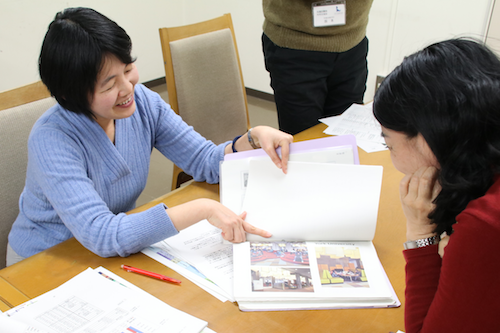
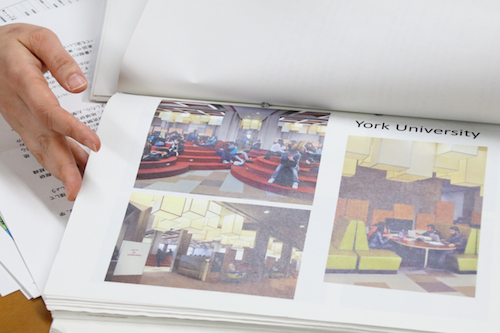
The "staircase" bench areas within York University Learning Commons (Canada), which Dr. Kitamura proposed to install in the planning discussion.
In the final phase, we compared a couple of design candidates proposed by graduate students of architecture major from Collaborative Graduate Program in Design, and made a final image that depicted people gathering at the root of a camphor tree and its branches stretching out. At the same time, the team agreed with a central theme of the Learning Commons as a "Experimental Learning Space." What it implies is that the Learning Commons should be a flexibly-operated space and run on an experimental basis rather than being an everlasting facility. If the current model doesn't fit the users' needs, all we have to do is to identify the cause of the misfit, and remodel the space. So after the first trial-and-error year, we called for an open discussion with staff and users and exchanged ideas the better use of the Learning Commons.
What we expect the Learning Commons users to experience in the "Experimental Learning Space" is "Wisdom Peeking."Kyoto University is a comprehensive university with a variety of intellectuals, but some of them stay too focused within their domain. One of the goals of the Learning Commons is to provide opportunities for these inward-focused people to be exposed to the highlights of other research topics and get fresh inspiration from the learning experience.
By this token, the learning commons organizes regular events called "Lecture Series."*5 The series invites researchers in their early careers to give an hour-long lecture about their research themes and background inside an open area of the Learning Commons. The cozy atmosphere of the Learning Commons encourages the audience to ask questions, thereby the series has been well received by participants.
A shared concept of the Learning Commons since it opened is that it is not a fixed space, but rather a "maturing space." It is upon us how to best use the limited space of Kyoto University by fine-tuning the balance between users' needs and available space.
What is the current status of the Learning Commons?
Sakamoto: Fortunately, it's always so crowded that users find it hard to find a spot to sit down.
Kitamura: With a growing need for facilities of this kind, we hope that similar spaces become broadly available across campuses.
Click here to the list of library facilities for learning support.
Not only Japanese and English! Multilingual Learning Support Desk
Is it true that Learning Support Desk located in the Learning Commons offers a wide variety of learning support activities?
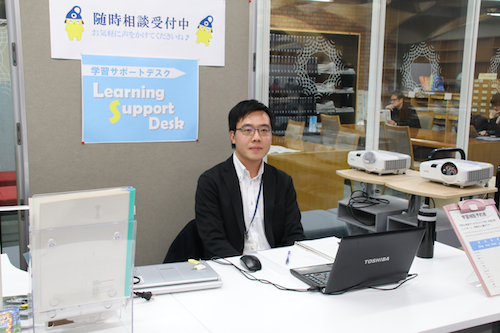
Image of Learning Support Desk. Mr. Cheng-yu Lin (a Learning Support Desk staff member, Ph.D. candidate of Graduate School of Law) on duty.
Sakamoto: Yes, some examples of what the Learning Support Desk offers include one-on-one tutoring on academic writing, checking library holdings data, coaching on how to use the database, answering questions on the use of the Learning Commons, and such. The Learning Support Desk also organizes workshops and events.
Who work as Learning Support Desk staff?
Sakamoto: Our Learning Support Desk staff consist of 7 graduate students in master and Ph.D. programs with different backgrounds. All are fluent in Japanese and English, and some of them can speak Chinese, French, and Urdu.
On top of Japanese and English, some of them can speak Chinese, French, and even Urdu! That's quite impressive. The multilingual environment should ease language barriers for international students so they can casually drop by and talk with the staff.
Sakamoto: Absolutely.
Talking about international students, I see that the Learning Support Desk offers "Library Tours for International Students" as one of its event series.
Sakamoto: That's right, library tours for international students were held about twice a day in mid-October 2017, making a total count of 10 sessions. We intentionally set the timing of the tour series to mid-October as a number of international students start their study in Kyoto in October.
With the number of international students surging in recent years, teaching staff and faculties must have found this kind of support really helpful.
Sakamoto: I hope so, and please encourage your students to swing by and use our services.
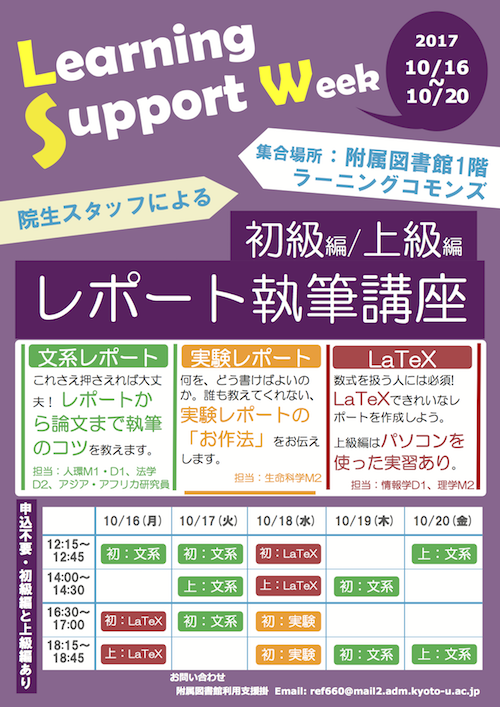
Flyer for the Academic Writing Workshop held in October 2017 (click the image to download the flyer in a PDF format)
Besides that, "Academic Writing Workshops" were held in June and October this year, which were organized by Learning Support Desk staff. The workshops were notably well attended. Topics of the writing workshops varied from academic writing for liberal arts students, how to cite articles, scientific writing, to how to use LaTeX. Among them, the LaTeX workshop was proposed and organized by our student staff, and gained positive feedback from the workshop attendees.
Referencing sources is an integral part of academic writing.
Sakamoto: That's true. In every workshop, we stress the importance of citing resources in a proper manner.
In some cases, faculty members have to take time to explain how to write papers to their students in class, so they should appreciate these extracellular writing workshops.
Sakamoto: Thank you for the comment.
Library Events and Workshops Addressing the Diverse Needs of Users
Aside from the events organized by the Learning Support Desk, the library hosts a variety of events and workshops.
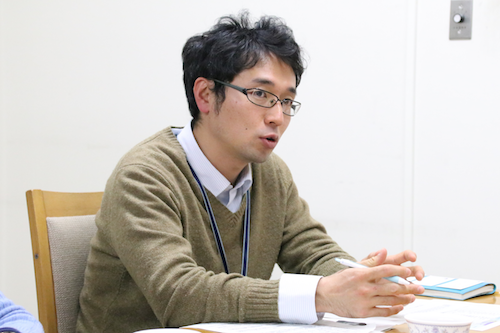
Sakamoto: Yes, the library offers library guidance and tours for new undergraduate and graduate students, and workshops on KULINE, RefWorks (reference management software), Web of Science and CiNii Articles (academic database), and such, held on a regular basis. The library also hosts workshops on how to search articles for writing papers and reports (literature search).
As databases have become more systematic than ever, students are prone to rely on their intuition to handle databases with a minimum effort and dare not sign up for these workshops. In reality, however, the students who have taken the workshops comment positively, saying "I had no idea about this kind of function", and "I learned so much from the workshop." Their comments signal well that students could find something new from these workshops. Anyone who is interested in any of our workshops is welcome to sign up.
Other than these regular workshops, you also offer in-class workshops?
Sakamoto: Right, if requested personally from individual faculty members, we send our librarians to perform in-class workshops.
I'm quite convinced that these workshops for students, like writing workshops, really save faculty members' efforts and time on teaching.
Sakamoto: I'm happy to hear the comment. I hope that faculty members inform their students of these regular workshops and encourage them to sign up.
Talking with you have prompted me to realize that library workshops and tours are doubly impactful, to students and to faculty members.
Sakamoto: That's true. Our ultimate goal is to offer support for faculty members in their educational aspects through organizing such workshops.
Kyoto University Library Network Workshop Calendar (image from April 2017. Click the image to jump to the most updated event calendar (external link).
In our former interview with Dr. Kitamura, she mentioned that in the "University Library Data Searching"*6 courses, early-career librarians give lectures in class. Who exactly are these librarians?
Sakamoto: They are mainly librarians ranging from the 1st through 5th years in the career. Their lectures are part of the SD (Staff Development) scheme, which motivates them to brush up their presentation skills as they are exposed to talking in front of students quite often. Also, they form groups to make handouts and references together to distribute in class, so they learn how to prepare materials effectively from each other.
*6 "University Library Data Searching": One of the Liberal Arts and General Education courses that Dr. Kitamura teaches. Click below for further details.
Hands-On Practice at the Library That Empowers Students to "Step Forward" (Released on March 19, 2019)
Do you think that giving them chances to give lectures has brought any positive changes to their attitudes, or in their roles and professionalism as a librarian?
Sakamoto: Librarians, in general, rarely communicate with students while at work. But through the teaching experiences, they become more aware that their job includes offering services to users, and are more tuned in to students' needs and trends. After all, I hope this practice continues to level up their professional qualities as librarians.
Last April, I signed up for the library tour, and was very impressed with the librarian's professional guide.
Sakamoto: You were there? Thank you for your participation.
Lastly, do you have any views on the advances of ICT and its use in academic and learning settings?
Sakamoto: There definitely is a growing need for electric resources, such as online books and journals. Library Network is prevailing the use of online and open access platforms by introducing KURENAI (Kyoto University Research Information Repository) and having journals and rare books accessible online. For the purpose of library book selection, the library offers a free trial subscription of online books for a fixed period*7. These online services are used on a frequent basis. The annual total number of paper-based books checked out from the library has been flat, but I personally see that more users are looking for online books.
*7 As a trial, Kyoto University Library offered a free trial subscription of the books on the ProQuest Ebook Central platform from October 20, 2017, through February 16, 2018.
I see. It can be translated that library services have a high affinity for ICT, reflecting the recent technology trends. Mr. Sakamoto and Dr. Kitamura, thank you so much for your time.
Questions asked by: Mana Taguchi and Takeo Suzuki
Article composition and Photography: Wataru Kono
Interview date: December 8, 2017
Published online: March 27, 2018 (Original article)
March 19, 2019 (English article)
